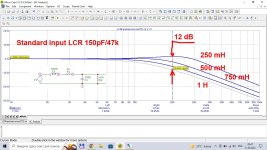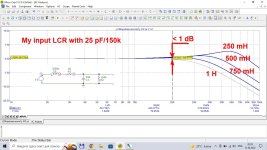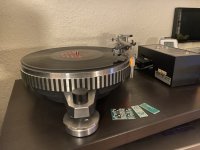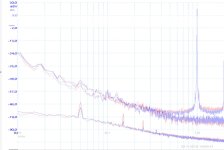Yes, it is really useful to not needed adjust C for different carts, because 99% audiomelomans have no 50 kHz sweep test LP (but I have!Benefit - there is no need to select C.
 - both Ortofon, Hi-Fi news and RR, JAES, and even DIN 45541 standard test disk -
- both Ortofon, Hi-Fi news and RR, JAES, and even DIN 45541 standard test disk - 
Attachments
I use Ohm`s as well as Kirchhoff/Johnson/Nyquist laws, Microcap12 sumulation, standard metrology and real measurements using Ortofon/HFNRR/JAES/DIN test disks [Nick uses his own definition of accepted terms and principles

Goog Cart has no mechanical resonances. I have measured dozens of modern cartridges and have not found any significant mechanical resonances in any of them. Of course, there are old cartridges with an overweight cantilever and a large stylus mass, but if they create mechanical resonance, you should simply throw them in the trash and not wear out the grooves of the records too intensively.You heavily disappoint me in pretending that a Cart is only composed of Lcart and Rcart.
Everything is clear with the "electrical" FR, here the 150K load has a clear advantage. But it is not clear with complete frequency response, including the mechanical properties of the cartridge. I do not have a test LP up to 50 kHz, so it would be interesting to see the real frequency response of different cartridges with a load of 150K.See attaches: mine delta 1 dB, standard 12 dB.
Leoniv,
There is nothing wrong with trying to find new ways to connect a MM cart.
But the final proof of the pudding has always to be by auditioning, confirming that no detoriation of sound can be perceived between the original connection and the newly proposed version.
And not just with one Cart, but with several Carts all having rather different properties.
Just using Lcart and Rcart in a simulation as Nick did, is completely inadequate, in that respect you did a more realistic simulation with a full model.
Cart’s are made as a vital part in the chain between Vinyl and speakers to produce music, not FR graphs.
Hans
There is nothing wrong with trying to find new ways to connect a MM cart.
But the final proof of the pudding has always to be by auditioning, confirming that no detoriation of sound can be perceived between the original connection and the newly proposed version.
And not just with one Cart, but with several Carts all having rather different properties.
Just using Lcart and Rcart in a simulation as Nick did, is completely inadequate, in that respect you did a more realistic simulation with a full model.
Cart’s are made as a vital part in the chain between Vinyl and speakers to produce music, not FR graphs.
Hans
Evaluation of the sound by ear is a very subjective thing. This can be very far away. I adhere to another approach - the tract should be good according to the devices, but the ear just gets used to everything. I know that the audiophiles enjoy the other, but I do not belong to them. 🙂
I do not exclude that there are old carts with a severe resonance. But now only modern mass market carts are interesting.
I do not exclude that there are old carts with a severe resonance. But now only modern mass market carts are interesting.
Of course, practice is the only criterion of truth, let him who hears hear [But the final proof of the pudding has always to be by auditioning
See my video @ #141, I have almost all test disks with 50 kHz sweep and made hundreds of FR measurements of a dozen modern carts like Ortofon, AT, Benz micro, Sumiko etc. Noone has any peak due to mechanical resonanceI do not have a test LP up to 50 kHz, so it would be interesting to see the real frequency response of different cartridges with a load of 150K.
 . But all have a 12 dB\oct roll off above LcartCintotal resonance frequency. No any disagreement with the William Thomson formula [ https://en.wikipedia.org/wiki/LC_circuit ] 🤓 . The measurements graphs were published @ my [ patreon.com/nick_sukhov ] and are my intellectual property.
. But all have a 12 dB\oct roll off above LcartCintotal resonance frequency. No any disagreement with the William Thomson formula [ https://en.wikipedia.org/wiki/LC_circuit ] 🤓 . The measurements graphs were published @ my [ patreon.com/nick_sukhov ] and are my intellectual property.
Last edited:
Record groove noise is maynly a flicker below 600 Hz while phono stage noise is spike peaking at 6-8 kHz. Therefore, -70 dBA phonocore spike is perfectly distinguished from the background of -60 dBA gramophone record groove noise. At 5 ... 10 kHz LP noise is even smaller than a CD 16bit/44kHz [ https://www.audioholics.com/audio-t...ynamic-comparison-of-lps-vs-cds-part-4-page-2 ] . There are many deaf people among people, so I don’t object to the opinion of those who do not listen to the phonocore spike or believe that class D amplifiers are better than class AB or class ABBA amplifiers.nything above 75dB-A S/N with Cart connected, although relatively easy to achieve with modern components, makes no sense because of the surface noise produced by Vinyl.
Last edited:
The only real difference between MC and MM is a LCR resonance of MM. With my proposed 150k\25pF input instead of "standard" 47k\150pF the MM-МC difference disappears, except 20 dB more EMF with MM. I focus on the fact that MC cartridges do not suffer from “mechanical resonance” despite the fact that their cantilevers and needles in modern models have the same equivalent mass as MM cantilevers and needles. But MM has 12 dB/octave rolloff upper LcartCinput resonance while MC has not resonances at all.MC cartridges give this response, and we've come to accept it as normal. For MM cartridges the choice between LCR loading optimized in the classic way, to flatten in-band response at the expense of a four pole ultimate rolloff, or some other loading
Last edited:
Words, words and nothing but words,Record groove noise is maynly a flicker below 600 Hz while phono stage noise is spike peaking at 6-8 kHz. Therefore, -70 dBA phonocore spike is perfectly distinguished from the background of -60 dBA gramophone record groove noise. At 5 ... 10 kHz LP noise is even smaller than a CD 16bit/44kHz [ https://www.audioholics.com/audio-t...ynamic-comparison-of-lps-vs-cds-part-4-page-2 ] . There are many deaf people among people, so I don’t object to the opinion of those who do not listen to the phonocore spike or believe that class D amplifiers are better than class AB or class ABBA amplifiers.
Here you see in one image at 1Khz from top to bottom first a 1Khz recording at 0dB, then the surface noise from a blank groove and finally the noise from a preamp with a 75dBA S/N.
The preamp's noise is everywhere more than 15dB below the Vinyl's surface noise.
Hans
Attachments
The first sentence seems to have difficulties when translated to English; it could mean either of two opposite meanings. The second sentence I think we could all agree.I focus on the fact that MC cartridges do not suffer from “mechanical resonance” despite the fact that their cantilevers and needles in modern models have the same equivalent mass as MM cantilevers and needles. But MM has 12 dB/octave rolloff upper LcartCinput resonance while MC has not resonances at all.
Except: all cartridges MC, MM, strain gauge, electrostatic, modulated light beam, anti-matter reactor, whatever, will all have the fundamental geometric and mechanical groove interface transfer curves imposed on them before they ever become "signal". Manufacturers advertizing 1dB response variations below 50kHz are not being honest, to put it politely. So, a real transfer curve must include a real geometric and mechanical source curve.
All good fortune,
Chris
Do you like to listen to sweep tone? Please, Ortofon test disk sweep 800 Hz - 50 kHz through a cartridge with a spherical stylus and my phono stageWe need graphs, not listening 🙂
This is not me, but the metrological standard IEC 268-15. The noise of the phono stage, regardless of whether it is an MC or MM cartridge and regardless of what input the phono stage has (voltage or current or intermediate) must be measured with an equivalent cartridge impedance connected to the phono stage input (10 ohms for MC and 500 mH + 1 kOhm for MM). The procedure is as follows: measure the IEC-A weighted rms voltage at the output and divide it by the 1 kHz gain between the phono stage + IEC-Awtdfilter output and the equivalent EMF node of the cartridge. The nominal input voltage of 5 mV for MM or 0.3 mV for MC is then divided by this input-referred noise voltage. All other “methods” are incorrect and are metrological deception. The only metrologically correct way to measure noise caused only by a phono preamplifier (without a cartridge noise) is to declare the cartridge resistor noiseless.You have to consider the cartridge as a voltage source in series with the cart resistance.
Nick,
Very Interesting, I didn’t know that metrological institutes, very busy with studying and forecasting the weather, had any time left to look at Carts.
Never too old to learn 🤣
Hans
P.S. the rest of your course in how to determine the S/N is a wide open door.
Very Interesting, I didn’t know that metrological institutes, very busy with studying and forecasting the weather, had any time left to look at Carts.
Never too old to learn 🤣
Hans
P.S. the rest of your course in how to determine the S/N is a wide open door.
This is simply to ensure a level playing field when assessing equipment and has nothing to do with all other methods being incorrect. Noise is a naturally occurring phenomenon, and calculating it is quite straightforward. Read Burkhardt Vogel's book 'The Sound of Silence' for a master class on low-noise design and how to calculate noise (with Mathcad files available for those that want to dig in really deep)This is not me, but the metrological standard IEC 268-15. The noise of the phono stage, regardless of whether it is an MC or MM cartridge and regardless of what input the phono stage has (voltage or current or intermediate) must be measured with an equivalent cartridge impedance connected to the phono stage input (10 ohms for MC and 500 mH + 1 kOhm for MM). The procedure is as follows: measure the IEC-A weighted rms voltage at the output and divide it by the 1 kHz gain between the phono stage + IEC-Awtdfilter output and the equivalent EMF node of the cartridge. The nominal input voltage of 5 mV for MM or 0.3 mV for MC is then divided by this input-referred noise voltage. All other “methods” are incorrect and are metrological deception. The only metrologically correct way to measure noise caused only by a phono preamplifier (without a cartridge noise) is to declare the cartridge resistor noiseless.
Most voltage input MC's specify loads of 50 to 400 Ohms, so I am at a loss to explain why they would choose 10 Ohms. And what happens when you use the MC cart in current generator or current injection mode?
That is my detailed masterclass (see the last 10 minutes) about correct noise measurements of phono preamps (and know-how about how replacing a cheap resistor is better than paralleling 15-$ transistors):P.S. the rest of your course in how to determine the S/N is a wide open door.
- Home
- Source & Line
- Analogue Source
- Pros and cons: prime MM\MC phonopreamps "X-Altra" & "LP797" vs "Cy-XXI"



